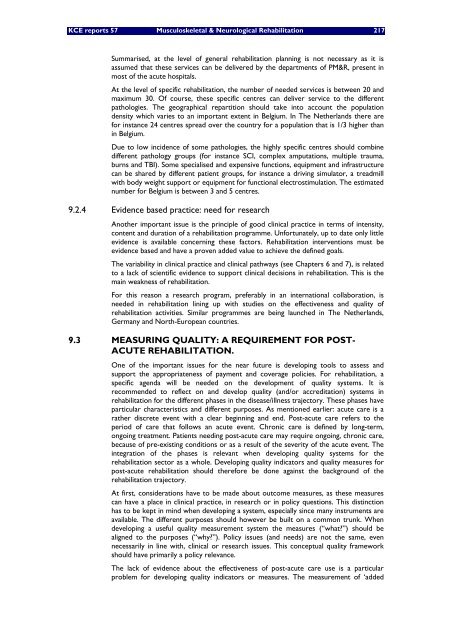The report is available in English with a French summary - KCE
The report is available in English with a French summary - KCE
The report is available in English with a French summary - KCE
You also want an ePaper? Increase the reach of your titles
YUMPU automatically turns print PDFs into web optimized ePapers that Google loves.
<strong>KCE</strong> <strong>report</strong>s 57 Musculoskeletal & Neurological Rehabilitation 217<br />
Summar<strong>is</strong>ed, at the level of general rehabilitation plann<strong>in</strong>g <strong>is</strong> not necessary as it <strong>is</strong><br />
assumed that these services can be delivered by the departments of PM&R, present <strong>in</strong><br />
most of the acute hospitals.<br />
At the level of specific rehabilitation, the number of needed services <strong>is</strong> between 20 and<br />
maximum 30. Of course, these specific centres can deliver service to the different<br />
pathologies. <strong>The</strong> geographical repartition should take <strong>in</strong>to account the population<br />
density which varies to an important extent <strong>in</strong> Belgium. In <strong>The</strong> Netherlands there are<br />
for <strong>in</strong>stance 24 centres spread over the country for a population that <strong>is</strong> 1/3 higher than<br />
<strong>in</strong> Belgium.<br />
Due to low <strong>in</strong>cidence of some pathologies, the highly specific centres should comb<strong>in</strong>e<br />
different pathology groups (for <strong>in</strong>stance SCI, complex amputations, multiple trauma,<br />
burns and TBI). Some special<strong>is</strong>ed and expensive functions, equipment and <strong>in</strong>frastructure<br />
can be shared by different patient groups, for <strong>in</strong>stance a driv<strong>in</strong>g simulator, a treadmill<br />
<strong>with</strong> body weight support or equipment for functional electrostimulation. <strong>The</strong> estimated<br />
number for Belgium <strong>is</strong> between 3 and 5 centres.<br />
9.2.4 Evidence based practice: need for research<br />
Another important <strong>is</strong>sue <strong>is</strong> the pr<strong>in</strong>ciple of good cl<strong>in</strong>ical practice <strong>in</strong> terms of <strong>in</strong>tensity,<br />
content and duration of a rehabilitation programme. Unfortunately, up to date only little<br />
evidence <strong>is</strong> <strong>available</strong> concern<strong>in</strong>g these factors. Rehabilitation <strong>in</strong>terventions must be<br />
evidence based and have a proven added value to achieve the def<strong>in</strong>ed goals.<br />
<strong>The</strong> variability <strong>in</strong> cl<strong>in</strong>ical practice and cl<strong>in</strong>ical pathways (see Chapters 6 and 7), <strong>is</strong> related<br />
to a lack of scientific evidence to support cl<strong>in</strong>ical dec<strong>is</strong>ions <strong>in</strong> rehabilitation. Th<strong>is</strong> <strong>is</strong> the<br />
ma<strong>in</strong> weakness of rehabilitation.<br />
For th<strong>is</strong> reason a research program, preferably <strong>in</strong> an <strong>in</strong>ternational collaboration, <strong>is</strong><br />
needed <strong>in</strong> rehabilitation l<strong>in</strong><strong>in</strong>g up <strong>with</strong> studies on the effectiveness and quality of<br />
rehabilitation activities. Similar programmes are be<strong>in</strong>g launched <strong>in</strong> <strong>The</strong> Netherlands,<br />
Germany and North-European countries.<br />
9.3 MEASURING QUALITY: A REQUIREMENT FOR POST-<br />
ACUTE REHABILITATION.<br />
One of the important <strong>is</strong>sues for the near future <strong>is</strong> develop<strong>in</strong>g tools to assess and<br />
support the appropriateness of payment and coverage policies. For rehabilitation, a<br />
specific agenda will be needed on the development of quality systems. It <strong>is</strong><br />
recommended to reflect on and develop quality (and/or accreditation) systems <strong>in</strong><br />
rehabilitation for the different phases <strong>in</strong> the d<strong>is</strong>ease/illness trajectory. <strong>The</strong>se phases have<br />
particular character<strong>is</strong>tics and different purposes. As mentioned earlier: acute care <strong>is</strong> a<br />
rather d<strong>is</strong>crete event <strong>with</strong> a clear beg<strong>in</strong>n<strong>in</strong>g and end. Post-acute care refers to the<br />
period of care that follows an acute event. Chronic care <strong>is</strong> def<strong>in</strong>ed by long-term,<br />
ongo<strong>in</strong>g treatment. Patients need<strong>in</strong>g post-acute care may require ongo<strong>in</strong>g, chronic care,<br />
because of pre-ex<strong>is</strong>t<strong>in</strong>g conditions or as a result of the severity of the acute event. <strong>The</strong><br />
<strong>in</strong>tegration of the phases <strong>is</strong> relevant when develop<strong>in</strong>g quality systems for the<br />
rehabilitation sector as a whole. Develop<strong>in</strong>g quality <strong>in</strong>dicators and quality measures for<br />
post-acute rehabilitation should therefore be done aga<strong>in</strong>st the background of the<br />
rehabilitation trajectory.<br />
At first, considerations have to be made about outcome measures, as these measures<br />
can have a place <strong>in</strong> cl<strong>in</strong>ical practice, <strong>in</strong> research or <strong>in</strong> policy questions. Th<strong>is</strong> d<strong>is</strong>t<strong>in</strong>ction<br />
has to be kept <strong>in</strong> m<strong>in</strong>d when develop<strong>in</strong>g a system, especially s<strong>in</strong>ce many <strong>in</strong>struments are<br />
<strong>available</strong>. <strong>The</strong> different purposes should however be built on a common trunk. When<br />
develop<strong>in</strong>g a useful quality measurement system the measures (“what?”) should be<br />
aligned to the purposes (“why?”). Policy <strong>is</strong>sues (and needs) are not the same, even<br />
necessarily <strong>in</strong> l<strong>in</strong>e <strong>with</strong>, cl<strong>in</strong>ical or research <strong>is</strong>sues. Th<strong>is</strong> conceptual quality framework<br />
should have primarily a policy relevance.<br />
<strong>The</strong> lack of evidence about the effectiveness of post-acute care use <strong>is</strong> a particular<br />
problem for develop<strong>in</strong>g quality <strong>in</strong>dicators or measures. <strong>The</strong> measurement of ‘added

















